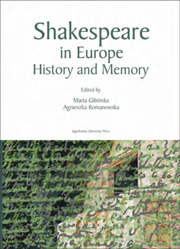Book contents
- Frontmatter
- Contents
- Preface
- Towards a European History of Henry V
- History and Histories
- The Bad Quarto Hamlet and the Polish Connection
- Cross-Histories, Straying Narratives: Anglo-Portuguese Imbrications and Shakespeare's History Plays
- The Art of War in Shakespeare and in European Renaissance Treatises
- The “Histories” of Henry VI
- Shakespeare's Imperfect Memory of History
- “Retail'd to All Posterity:” The Case of Richard III
- Halting Modernity: Richard III's Preposterous Body and History
- History and Memory: Criticism and Reception
- History, Memory, and Ideological Appropriation
- Theatre: The Act of Memory and History in the Making
- Index of Authors
The Bad Quarto Hamlet and the Polish Connection
from History and Histories
Published online by Cambridge University Press: 05 September 2014
- Frontmatter
- Contents
- Preface
- Towards a European History of Henry V
- History and Histories
- The Bad Quarto Hamlet and the Polish Connection
- Cross-Histories, Straying Narratives: Anglo-Portuguese Imbrications and Shakespeare's History Plays
- The Art of War in Shakespeare and in European Renaissance Treatises
- The “Histories” of Henry VI
- Shakespeare's Imperfect Memory of History
- “Retail'd to All Posterity:” The Case of Richard III
- Halting Modernity: Richard III's Preposterous Body and History
- History and Memory: Criticism and Reception
- History, Memory, and Ideological Appropriation
- Theatre: The Act of Memory and History in the Making
- Index of Authors
Summary
Over a hundred years ago Israel Gollancz suggested a link between the character of Polonius – Corambis in the “Bad Quarto” of Hamlet – and The Counsellor, an English translation published in 1598 of De Optimo Senatore, a well-known speculum book published in Venice in 1568 (2nd edition Basel, 1593) by the Polish humanist Wawrzyniec Grymała Goślicki (Goslicius). The claim has remained in the realm of hypothesis and speculation, largely because the research undertaken hitherto has been too limited in approach. Only recently has new work and the availability of new documentation and facts enabled progress to be made in the search for a viable answer as to why the character known as “Polonius” in the Second Quarto (Q2 – 1604/5), the 1623 Folio and subsequent editions of Hamlet is “Corambis” in Q1, the “Bad Quarto” of 1603.
My solution to this problem, which has perplexed scholars of Q1 ever since the Bad Quarto's discovery in the nineteenth century, is not prejudicial to either the memorial reconstruction theory of the origins of Q1, nor to the revision theory, nor to any of the hybrid explanations deriving from a mixture of these two apparently antagonistic hypotheses. It is independent of the vagaries scholarship is taking in the quest for an answer how Q1 arose. However, in explaining part of the “why” behind Q1 and Q2 it may throw light on some of the mechanisms involved in the emergence of texts as diverse as Q1, Q2 and F1.
- Type
- Chapter
- Information
- Shakespeare in EuropeHistory and Memory, pp. 35 - 44Publisher: Jagiellonian University PressPrint publication year: 2008



